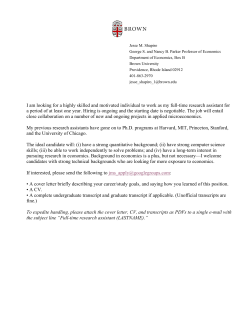
LESSON ONE Introduction to Economics
E C O N ( E N T ) C O U R S E LESSON ONE Introduction to Economics CHAPTER 1 What is Economics? CHAPTER 2 Economic Systems and the American Economy Introduction to the Course | 13 EXERCISES Matching (22 points) From the list below, select the term that matches each of the following statements. 1. system where government controls the factors of production and makes all decisions about their use 2. foregoing one good or service purchase or produce another one 3. human effort directed toward producing goods and services 4. system where private individuals own the factors of production and decide how to use them 5. natural resources 6. expansion of the economy to produce more goods, jobs, and wealth 7. balancing economic policy everyone benefits fairly 8. the condition of wants exceeding all available resources 9. material well-being as measured by how well necessities and luxuries are satisfied so to A. B. C. D. E. F. G. H. I. J. K. land scarcity economic equity economic growth trade-off command economy standard of living labor traditional economy capital capitalism that 10. system in which economic decisions are based on customs that have been handed down for generations 11. previously manufactured goods used to make other goods and services Multiple Choice (38 points) 1. We are forced to make choices because A. B. C. D. 2. The four factors of production are the resources of land, labor, capital, and A. B. C. D. | not everything is limited. we live in a democracy. all resources are limited. shortages are a constant situation. entrepreneurship. services. technology. goods. 42 ECON (ENT) COURSE --Economics and the Free Enterprise System 3. A truck used by a plumber is a type of A. B. C. D. 4. The value of the next best alternative that had to be given up to do the action that was chosen is the A. B. C. D. 5. quota system. command economy. laissez-faire system. mixed economy. The desire to make money that motivates people to produce goods and services is called A. B. C. D. 9. entrepreneurship. slave labor. the market. the government. Pure capitalism is also known as a A. B. C. D. 8. trade-offs. production possibilities. costs. factors of production. When Adam Smith coined the term “invisible hand,” he was referring to A. B. C. D. 7. trade-off. sale price. capital. opportunity cost. All the combinations of goods and services that can be produced in a given time with a fixed amount of resources are called A. B. C. D. 6. modus transportius. raw good. capital. labor. the profit incentive. entrepreneurship. greed. laissez-faire. Which country best follows the ideas of Adam Smith? A. B. C. D. North Korea China Singapore Cuba 10. Productivity refers to A. B. C. D. using the four factors of production. producing goods and services in better and faster ways. measuring sales. creating goods and services. Lesson One - Introduction to Economics | 43 11. Which of the following is a strength of a market economy? A. B. C. D. No one is allowed to live in poverty. It offers guaranteed lifetime employment. It provides centralized planning. It gives producers and consumers a great deal of freedom. 12. Today most economic systems are A. B. C. D. mixed. traditional. capitalist. command. 13. The goal of economic freedom is to A. B. C. D. limit competition. give government a large role in the economy. ensure that businesses don’t fail. allow people to make choices. 14. Unemployment compensation helps provide economic A. B. C. D. growth. stability. equity. freedom. 15. Since the founding of the United States, the role of government in the economy has A. B. C. D. decreased. increased. had no impact on individual economic choices. been eliminated. 16. Zoning regulations are an example of A. B. C. D. the role of government in regulating economic activities. a traditional economy. the lack of government involvement in economic activities. a pure market economy. 17. When analyzing an economic problem, economists do not consider A. B. C. D. government regulations. choices. resources. values. 18. A free enterprise system involves trade-offs between A. B. C. D. | state and federal government. businesses in the same industry. individual gain and social equity. customs and beliefs. 44 ECON (ENT) COURSE --Economics and the Free Enterprise System 19. Which of the following is an example of a good? A. B. C. D. a car wash a car a tune-up an oil change 20. Capitalism is also known as a A. B. C. D. free market system. mixed economy. quota system. command economy. Short Answer and Essay (20 points) 1. Short Answer - Factors of production: Pick a good or service and describe how each of the factors of production is present in that good or service. See the following example: Example: Johnny has a mobile car wash. • Capital = the vehicle used to pull the car wash equipment and the equipment itself • Labor = Johnny’s and anyone he may hire to help • Land = the water • Entrepreneurship = Johnny is providing it as he has purchased the capital and is risking this investment to create a business Lesson One - Introduction to Economics | 45
© Copyright 2025





















